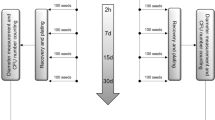Abstract
The aim of this study was to investigate the toxicity of herbicides (metribuzin and glyphosate), insecticides (imidacloprid and thiamethoxam) and fungicides (hexaconazole, metalaxyl and kitazin) at the recommended and the higher dose rates on plant growth promoting activities of Bradyrhizobium sp. under in vitro conditions. The Bradyrhizobium sp. strain MRM6 was isolated from nodules of greengram plants. Pesticide-concentration dependent progressive-decline was observed in plant growth promoting traits of the strain MRM6 apart from exo-polysaccharides which increased consistently on increasing pesticide concentrations. Generally, the highest toxicity to plant growth promoting characteristics of the Bradyrhizobium sp. strain MRM6 was observed when the strain MRM6 was grown with three times the recommended field rates of glyphosate, imidacloprid and hexaconazole.
Similar content being viewed by others
References
Ahemad M, Khan MS, Zaidi A, Wani PA (2009) Remediation of herbicides contaminated soil using microbes. In: Khan MS, Zaidi A, Musarrat J (eds) Microbes in sustainable agriculture. Nova Science Publishers Inc., New York, pp 261–284
Alexander DB, Zuberer DA (1991) Use of chrome azurol S reagents to evaluate siderophore production by rhizosphere bacteria. Biol Fertil Soils 12:39–45
Allievi L, Gigliotti C (2001) Response of the bacteria and fungi of two soils to the sulfonylurea herbicide cinosulfuron. J Environ Sci Health Part B 36:161–175
Bakker AW, Schipper B (1987) Microbial cyanide production in the rhizosphere in relation to potato yield reduction and Pseudomonas spp. mediated plant growth stimulation. Soil Biol Biochem 19:451–457
Bellinaso ML, Greer CW, Peralba MC, Henriques JA, Gaylarde CC (2003) Biodegradation of the herbicide trifluralin by bacteria isolated from soil. FEMS Microb Ecol 43:191–194
Boldt TS, Jacobsen CS (1998) Different toxic effects of the sulphonylurea herbicides metsulfuron methyl, chlorsulfuron and thifensulfuron methyl on fluorescent pseudomonads isolated from an agricultural soil. FEMS Microbiol Lett 161:29–35
Brick JM, Bostock RM, Silversone SE (1991) Rapid in situ assay for indole acetic acid production by bacteria immobilized on nitrocellulose membrane. Appl Environ Microbiol 57:535–538
Chitra RS, Sumitra VC, Yash DS (2002) Effect of different nitrogen sources and plant growth regulators on glutamine synthetase and glutamate synthase activities of radish cotyledons. Bulg J Plant Physiol 28:46–56
Dunfield KE, Siciliano SD, Germida JJ (2000) The fungicides thiram and captan affect the phenotypic characteristics of Rhizobium leguminosarum strain C1 as determined by FAME and Biolog analyses. Biol Fertil Soils 31:303–309
Dye DW (1962) The inadequacy of the usual determinative tests for the identification of xanthomonas spp. Nat Sci 5:393–416
Gordon S, Weber RP (1951) The colorimetric estimation of IAA. Plant Physiol 26:192–195
Herman PL, Behrens M, Chakraborty S, Crastil BM, Barycki J, Weeks DP (2005) A three component dicamba O-demethylase from Pseudomonas maltiphilia strain DI-6: gene isolation, characterization and heterologous expression. J Biol Chem 280:24759–24767
Holt JG, Krieg NR, Sneath PHA, Staley JT, Willams ST (1994) Bergey’s manual of determinative bacteriology, 9th edn. Williams and Wilkins, USA
Johnsen K, Jacobsen CS, Torsvik V, Sorensen J (2001) Pesticide effects on bacterial diversity in agricultural soils-a review. Biol Fertil Soils 33:443–453
Kang BG, Kim WT, Yun HS, Chang SC (2010) Use of plant growth-promoting rhizobacteria to control stress responses of plant roots. Plant Biotechnol Rep. doi:10.1007/s11816-010-0136-1
Khan MS, Zaidi A, Ahemad M, Oves M, Wani PA (2010) Plant growth promotion by phosphate solubilizing fungi-current perspective. Arch Agron Soil Sci 56:73–98
Kumar S, Mukerji KG, Lal R (1996) Molecular aspects of pesticide degradation by microorganisms. Critic Rev Microbiol 22:1–26
Kumar N, Anubhuti Bora JI, Amb MK (2010) Chronic toxicity of the triazole fungicide tebuconazole on a heterocystous, nitrogen-fixing rice paddy field cyanobacterium, Westiellopsis prolifica Janet. J Microbiol Biotechnol 20:1134–1139
Miethke M, Marahiel MA (2007) Siderophore-based iron acquisition and pathogen control. Microbiol Mol Biol Rev 71:413–451
Mody BR, Bindra MO, Modi VV (1989) Extracellular polysaccharides of cowpea rhizobia: compositional and functional studies. Arch Microbiol 1:2–5
Ortiz-Hernández ML, Sánchez-Salinas E (2010) Biodegradation of the organophosphate pesticide tetrachlorvinphos by bacteria isolated from agricultural soils in México. Rev Int Contam Ambient 26:27–38
Reeves MW, Pine L, Neilands JB, Balows A (1983) Absence of siderophore activity in Legionella species grown in iron-deficient media. J Bacteriol 154:324–329
Somasegaran P, Hoben HJ (1994) Handbook for rhizobia: methods in legume Rhizobium technology. Springer, New York
Tank N, Saraf M (2003) Phosphate solubilization, exopolysaccharide production and indole acetic acid secretion by rhizobacteria isolated from Trigonella foenum-graecum. Ind J Microbiol 43:37–40
Vincent JM (1970) A manual for the practical study of root nodule bacteria, IBP handbook no. 15. Blackwell Scientific Publications, Oxford, UK
Wani PA, Zaidi A, Khan AA, Khan MS (2005) Effect of phorate on phosphate solubilization and indole acetic acid releasing potentials of rhizospheric microorganisms. Ann Pl Protec Sci 13:139–144
Acknowledgments
The authors thank to Dr. Nakhat Ara Naqvi, Parijat Agrochemicals, New Delhi, India, for providing technical grade pesticides and University Grants Commission (UGC), New Delhi for financial support.
Author information
Authors and Affiliations
Corresponding author
Rights and permissions
About this article
Cite this article
Ahemad, M., Khan, M.S. Effect of Pesticides on Plant Growth Promoting Traits of Greengram-Symbiont, Bradyrhizobium sp. strain MRM6. Bull Environ Contam Toxicol 86, 384–388 (2011). https://doi.org/10.1007/s00128-011-0231-1
Received:
Accepted:
Published:
Issue Date:
DOI: https://doi.org/10.1007/s00128-011-0231-1




